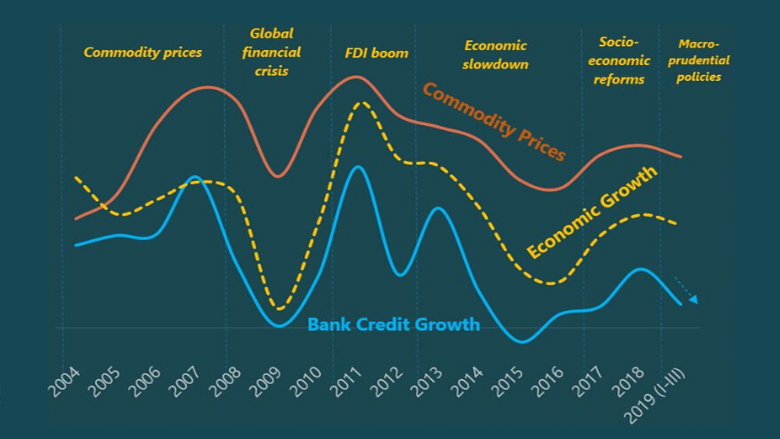This edition of the Mongolia Economic Update provides an analysis of the recent economic developments and Mongolia’s medium-term economic outlook.
- Following strong recovery over the past two years, Mongolia’s growth began to moderate in 2019. The strong economic recovery since 2017 has been underpinned by impressive fiscal outcomes, better coordination of macroeconomic policy, favorable global commodity prices, and strong recovery in private investment. Real GDP growth strengthened to 7.2 percent in 2018 from 5.3 percent in 2017. Following the gradual decline in commodity prices combined with a reduction in the quality of key mineral exports, growth moderated to 6.3 percent in the first nine months of 2019 and is expected to slow to 5.8 percent for the year as a whole.
- Medium-term growth prospects remain positive, largely supported by robust growth in private consumption and continued steady investment in mining and manufacturing. This forecast is predicated on the government’s continued commitment to fiscal consolidation to contain public debt in the medium term by improving revenue mobilization and controlling public spending.
- There are significant downside risks to the growth outlook emanating from heightened uncertainties in the global and domestic environments:
- Possible relaxation of the government’s commitment to reforms on the eve of the general elections in 2020, thereby affecting market sentiment and the flow of foreign direct investment.
- Uncertainty surrounding the potential impact of the U.S.A.-China trade deal, especially China’s energy imports from non-US sources. At the same time, a renewed flare up of international trade tensions could depress global growth and exert downward pressure on commodity prices.
- Possible adverse impact from the novel coronavirus outbreak given the strong economic linkages between China and Mongolia.
- Impact on Mongolia’s coal exports of the resumption of non-trade barriers at the border with China.
- Limited progress on recapitalization of the banking sector.
- Slow progress on anti-money laundering issues as Mongolia remains on the gray list of the Financial Action Task Force (FATF).
The report also includes a special topic on the analysis of bank credit developments.
- Mongolia has experienced several episodes of high credit growth, most recently during the second half of 2018. Past episodes of rapid credit expansion included 2005–08, 2010–11, and 2013–14. In 2018, bank credit to the economy grew annually by about 26.5 percent in nominal terms and 15.4 percent in real terms. Historically bank deposits, GDP growth, and commodity prices were the key drivers of credit growth.
- Household debt has increased as most of the credits were channeled to individuals. The recent rapid credit expansion was channeled mostly to individuals mainly through mortgage loans, salary and pension loans, as well as consumption loans. Consequently, the average household debt-to-income ratio was estimated at over 90 percent at the end of 2018, up from 39 percent in 2012.
- Adequate credit management is crucial to economic growth as credit and GDP growth rates are generally closely correlated in Mongolia. Credit development in Mongolia was largely driven by economic recoveries at the end of 2005, the beginning of 2010, and 2017. In 2011, however, a greater inflow of FDI was a key factor. Since 2013, the government subsidized mortgage program fueled credit growth. More recently, non-mortgage consumer loans were the key driver of credit growth.
In summary, the following findings emerge from the special topic of this Mongolia Economic Update:- Credit growth has been excessive and volatile.
- Credit policy was procyclical.
- Household and corporate debt are high.
- Funding and loans are highly concentrated.
- Level of provisioning and savings are low.
- Unconventional credit policies are common.
- Fiscal dominance is observed.
- Credit allocation and the diversification agenda are not matched.
Key policy priorities:
- Strengthen fiscal buffers through continued fiscal consolidation.
- Build up reserves sufficiently to fully mitigate the potential impact of negative shocks.
- Strengthen financial sector stability (recapitalization of banks, banking regulation and monitoring).
- Continue implementation of macroprudential policies to curb excessive and volatile credit growth.
